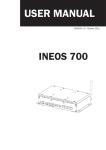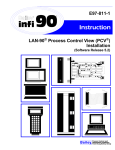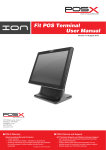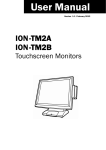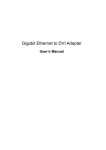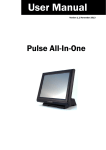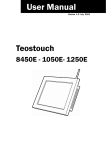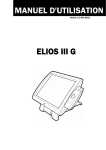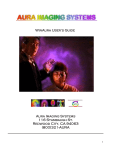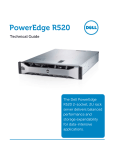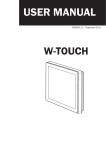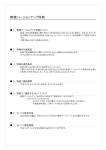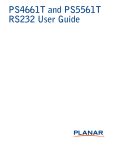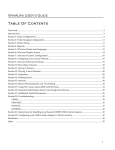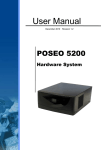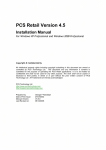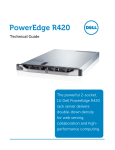Download User Manual - Support Technique AURES
Transcript
User Manual Version 1.0 April 2015 NINÔ II Copyright 2015 All Rights Reserved Manual Version 1.0 The information contained in this document is subject to change without notice. We make no warranty of any kind with regard to this material, including, but not limited to, the implied warranties of merchantability and fitness for a particular purpose. We shall not be liable for errors contained herein or for incidental or consequential damages in connection with the furnishing, performance, or use of this material. This document contains proprietary information that is protected by copyright. All rights are reserved. No part of this document may be photocopied, reproduced or translated to another language without the prior written consent of the manufacturer. TRADEMARK Intel®, Pentium® and MMX are registered trademarks of Intel® Corporation. Microsoft® and Windows® are registered trademarks of Microsoft Corporation. Other trademarks mentioned herein are the property of their respective owners. i Safety IMPORTANT SAFETY INSTRUCTIONS 1. 2. 3. 4. 5. 6. 7. 8. 9. To disconnect the machine from the electrical Power Supply, turn off the power switch and remove the power cord plug from the wall socket. The wall socket must be easily accessible and in close proximity to the machine. Read these instructions carefully. Save these instructions for future reference. Follow all warnings and instructions marked on the product. Do not use this product near water. Do not place this product on an unstable cart, stand, or table. The product may fall, causing serious damage to the product. Slots and openings in the cabinet and the back or bottom are provided for ventilation; to ensure reliable operation of the product and to protect it from overheating. These openings must not be blocked or covered. The openings should never be blocked by placing the product on a bed, sofa, rug, or other similar surface. This product should never be placed near or over a radiator or heat register, or in a built-in installation unless proper ventilation is provided. This product should be operated from the type of power indicated on the marking label. If you are not sure of the type of power available, consult your dealer or local power company. Do not allow anything to rest on the power cord. Do not locate this product where persons will walk on the cord. Never push objects of any kind into this product through cabinet slots as they may touch dangerous voltage points or short out parts that could result in a fire or electric shock. Never spill liquid of any kind on the product. CE MARK This device complies with the requirements of the EEC directive 2004/108/EC with regard to “Electromagnetic compatibility” and 2006/95/EC “Low Voltage Directive” FCC This device complies with part 15 of the FCC rules. Operation is subject to the following two conditions: (1) This device may not cause harmful interference. (2) This device must accept any interference received, including interference that may cause undesired operation ii CAUTION ON LITHIUM BATTERIES There is a danger of explosion if the battery is replaced incorrectly. Replace only with the same or equivalent type recommended by the manufacturer. Discard used batteries according to the manufacturer’s instructions. Battery Caution Risk of explosion if battery is replaced by an incorrectly type. Dispose of used battery according to the local disposal instructions. Safety Caution Note: To comply with IEC60950-1 Clause 2.5 (limited power sources, L.P.S) related legislation, peripherals shall be 4.7.3.2 "Materials for fire enclosure" compliant. 4.7.3.2 Materials for fire enclosures For MOVABLE EQUIPMENT having a total mass not exceeding 18kg.the material of a FIRE ENCLOSURE, in the thinnest significant wall thickness used, shall be of V-1 CLASS MATERIAL or shall pass the test of Clause A.2. For MOVABLE EQUIPMENT having a total mass exceeding 18kg and for all STATIONARY EQUIPMENT, the material of a FIRE ENCLOSURE, in the thinnest significant wall thickness used, shall be of 5VB CLASS MATERIAL or shall pass the test of Clause A.1 LEGISLATION AND WEEE SYMBOL 2012/19/EU Waste Electrical and Electronic Equipment Directive on the treatment, collection, recycling and disposal of electric and electronic devices and their components. The crossed dustbin symbol on the device means that it should not be disposed of with other household wastes at the end of its working life. Instead, the device should be taken to the waste collection centers for activation of the treatment, collection, recycling and disposal procedure. To prevent possible harm to the environment or human health from uncontrolled waste disposal, please separate this from other types of wastes and recycle it responsibly to promote the sustainable reuse of material resources. Household users should contact either the retailer where they purchased this product, or their local government office, for details of where and how they can take this item for environmentally safe recycling. Business users should contact their supplier and check the terms and conditions of the purchase contract. This product should not be mixed with other commercial wastes for disposal. iii Revision History Revision Date V1.0 April, 2015 Description iv Release Table of Contents 1 Item Checklist................................................ 1 1-1 1-2 Standard Items ............................................................................... 1 Optional Items ................................................................................ 2 2 System View ................................................... 3 2-1 2-2 2-3 2-4 2-5 Front View & Rear View .................................................................. 3 Side View ........................................................................................ 4 Bottom View .................................................................................... 4 Dimension & View Angle ................................................................ 5 I/O View........................................................................................... 7 3 System Assembly & Disassembly ................. 8 3-1 3-2 3-3 Install the Power Adapter ............................................................... 8 Replace the HDD ............................................................................ 9 Replace the SSD Card.................................................................... 9 4 Peripherals Installation .............................. 10 4-1 4-2 4-3 4-4 4-5 4-6 4-7 Install the MSR Module ............................................................... 10 Install the iButton Module ........................................................... 11 Install the Addimat Key Reader ................................................... 12 Install the Customer Display (Graphic LCM) ............................... 13 Install the 2nd Display................................................................... 14 4-5-1 How to activate the 2nd display Under Windows................................ 17 Install the Wall Mount Kit ............................................................ 20 Install the Cash Drawer................................................................ 23 5 Specification ............................................... 25 6 Configuration .............................................. 27 6-1 6-2 6-3 D36 Motherboard Layout ............................................................ 27 Connectors & Functions .............................................................. 28 Jumper Settings ........................................................................... 29 Appendix: Driver Installation......................... 32 v 1 Item Checklist 1-1 Standard Items a. System b. Power adapter (65W) c. Power cable d. RJ45-DB9 cable (x4) e. Manual CD 1 1-2 Optional Items a. MSR module b. iButton module c. Addimat reader d. Customer display ( Graphic LCM ) e. 2nd display f. Wall Mount kit 2 2 System View 2-1 Front View & Rear View Number Description 1 LED indicator 2 Touch screen 3 Thumb screw for the cable cover 4 Ventilation hole 5 HDD door 6 VFD/2nd display dummy cover 7 MSR/iButton/Addimat key module dummy cover 8 Swing arm base 3 2-2 Side View Fold down the swing arm base 2-3 Bottom View Number Description 1 Rubber foot 2 Power adapter (with holder bracket) 3 IO ports 4 2-4 Dimension & View Angle 5 6 2-5 I/O View Number Description a Line out b Display port c Mic in d Power button e 19V DC in f VGA g COM1~3 (from right to left) h USB x 4 (USB2.0) i Cash drawer j USB x 2 (USB3.0) k LAN 7 3 System Assembly & Disassembly 3-1 Install the Power Adapter The system is equipped with a 65W power adapter. install the power adapter. Please follow the steps below to 1. The swing arm base is designed to allow for clean cable management. There is a cable channel through the swing arm base, which has a quick access cover. Please loosen the thumb screw (x1) of the cable cover first. 2. Lay down system to access the bottom of the base. Remove the screws (x2) of the holder bracket. 3. Attach the power adapter and then replace the holder bracket. 4. 5. 6. Route the cable as shown in the picture. Connect the power adapter to the 19V DC IN port. Replace the cable cover. 8 3-2 3-3 Replace the HDD 1. Remove the HDD/SSD cover retaining a screw and sliding the drive out. 2. Unclip the HDD cover from the drive as shown in the picture. Replace the SSD Card 1. Remove the HDD/SSD cover retaining a screw and sliding the drive out. 2. Remove the screws (x4) that fix the SSD card to the bracket. 9 4 Peripherals Installation 4-1 Install the MSR Module MSR is installed on the right side of the system. powered down before starting. 1. Remove the dummy cover first. 2. Connect the MSR cable (x1) to the connector on the system side. 3. Insert the MSR module in place and fasten the screws (x2) on the back to secure the module. 10 Please make sure the unit is 4-2 Install the iButton Module iButton is installed on the left side of the system. powered down before starting. 1. Remove the dummy cover first and then unfasten the screws (x2). 2. Connect the iButton cable to the connector on the system side. 3. Insert the iButton module in place and fasten the screws (x2) on the back to secure the module. 11 Please make sure the unit is 4-3 Install the Addimat Key Reader Addimat key reader is an option instead of iButton module. It is also installed on the left side of the system. Please make sure the unit is powered down before starting. 1. Remove the dummy cover first and then unfasten the screws (x2). 2. Connect the addimat key reader cable to the connector on the system side. 3. Insert the addimat key reader in place and fasten the screws (x2) on the back to secure the module. 12 4-4 Install the Customer Display (Graphic LCM) 1. Remove the dummy cover first. 2. After the dummy cover is removed, plug the 8-pin LCM cable into the CN8 / LCM connector on the system board. 3. Fasten the screws (x2) to secure the LCM display to the system. The Customer Display is directly connected to COM6 and uses the following communication parameters: 9600, N, 8, 1. 13 4-5 Install the 2nd Display 1. Loosen the thumb screw (x1) of the cable cover first. 2. Attach the 2nd display on to the swing arm base and fasten the screws(x2) to fix the 2nd display. 3. Lay down system to access the bottom of the base. Loosen the screws (x2) of the holder bracket to release the power adapter. 14 4. After the power adapter is released, a nameplate is attached to the edge of the swing arm base. Remove this nameplate as shown in the picture. 5. After the nameplate is removed, a small hole is revealed. Thread the cable of 2nd display through the hole and then route the cable as shown in the picture. Attach the power adapter and screw the holder bracket. 6. 7. Plug the 2nd display cable to the USB port on the IO panel. 15 8. Finally put the cable cover back and fasten the thumb screw. 16 4-5-1 How to activate the 2nd display Under Windows Make sure to connect the 2nd display cable and begin the installation after your system has booted. The Setup program requires about one minute for the installation. If you turn the power off or remove the 2nd display cable while the Setup program is running, it may cause an error with the Windows operating system. The optimal resolution for this USB monitor is 1024 x 600. When the installation is completed, configure the following settings to activate the 2nd display. 1. Click the Start button Picture of the Start button in the lower-left corner of the screen. 2. Click the Control Panel to change the setting and customize the functionality of the system. 17 3. Click the Appearance and Personalization to enter the menu. 4. Select Display from the menu and the display properties windows appears. 18 5. Arrange the monitors displayed in the order they are actually used. 6. Remember to click Apply before exiting the menu. 7. Click Keep Changes and then click OK to save the setting. 19 4-6 Install the Wall Mount Kit The wall mount come with the following parts: 8mm screw x 8 4 mm screw x 1 Mounting bracket 1. First attach the four mounting clips using the 3 mm screws as shown in the picture. 2. Next attach the mounting bracket to the wall or other surface using at least four of the bracket mounting holes. Please note that the bracket has both a 100mm and 75mm hole pattern, so that the bracket can be used with the VESA bracket as well as being directly mounted to a wall. 20 Mounting Clip x 4 3. Next step is to route any cables you need to go to the system as required. A space is provided just by the power supply for the cable to exit cleanly, assuming they are routed via the swing arm cable channel as in a normal install. Cables can also be routed down as well. Be sure cables are clear or protected of any sharp surfaces. You can remove the system on and off the wall mount bracket as needed to route the cables. 4. Cables can exit the top or bottom when routed between the bracket and system. A wall hole could be used to cover the cables in the power supply area. 5. The final step is to install the locking safety screw. This screw is to insure the system is not knocked of the wall by accident . The 4 mm screw supplied is used for this propose. First remove the rubber hole plug from the system, then screw in the safety screw. The system is now secure enough and the swing base can be adjusted to the desired viewing angle. 21 Some possible viewing angles using the wall mount bracket. 22 4-7 Install the Cash Drawer You can install a cash drawer through the cash drawer port. Please verify the pin assignment before installation. Cash Drawer Pin Assignment Pin 1 2 3 4 5 6 Signal Cash drawer 2 In Cash drawer 1 Out Cash drawer 1 In 12V / 19V (OR 24v) Cash drawer 2 Out GND Cash Drawer Controller Register The Cash Drawer Controller use one I/O addresses to control the Cash Drawer. Register Location: 0x482h Attribute: Read / Write Size: 8bit BIT BIT7 BIT6 Attribute CD2 Out Reserved 7 6 X 5 4 3 2 1 0 X X X BIT5 CD2 In BIT4 CD1 Out BIT3 CD1 In Reserved Cash Drawer 1 pin input control Cash Drawer 1 pin output control Cash Drawer 2 pin input control Reserved Cash Drawer 2 pin output control 23 BIT2 BIT1 BIT0 Reserved Bit 7: Cash Drawer 2 pin output control Bit 6: Reserved Bit 5: Cash Drawer 2 pin input control Bit 4: Cash Drawer 1 pin output control. = 1: Opening the Cash Drawer = 0: Allow close the Cash Drawer Bit 3: Cash Drawer 1 pin input control. = 1: the Cash Drawer closed or no Cash Drawer = 0: the Cash Drawer opened Bit 2: Reserved Bit 1: Reserved Bit 0: Reserved Note: Please follow the Cash Drawer control signal design to control the Cash Drawer. Cash Drawer Control Command Example Use Debug.EXE program under DOS or Windows98 Command Cash Drawer O 482 04 Opening O 482 00 Allow to close Set the I/O address 482h bit4 =1 for opening Cash Drawer by “DOUT bit0” pin control. Set the I/O address 482h bit4 = 0 for allow close Cash Drawer. Command Cash Drawer I 482 Check status The I/O address 482h bit3 =1 mean the Cash Drawer is opened or not exist. The I/O address 482h bit3 =0 mean the Cash Drawer is closed. 24 5 Specification Model Name NINÔ II Motherboard D36 Intel Bay Trail SoC Celeron J1900 2.0GHz, L2 2MB, TDP 10W (default) NA CPU support Chipset System memory DDR3L S.O. DIMM x1, FSB 1066/1333hz, default 2G, max. 8G Graphic memory Intel HD Graphic DX11.1 LAN controller Audio controller Realtek RTL8111E-VL-CG 10/100/1000 baseT LAN Realtek ALC662VDO-GR I/O controller Touch controller Winbond NCT6106D to be defined major SKU with PCAP only or both PCAP/TF RES.Touch BIOS Phoenix UEFI code Board dimension 185 (W) x 130 (D) mm LCD Touch Panel LCD size 14" LED panel Brightness Maximal resolution Touch screen type Tilt angle 200 nits up 1366*768 True Flat resistive touch (USB) True Flat projected capacitive touch (USB) 0°~ 90° Storage HDD one 2.5" SATA HDD bay, 320 GB standard SSD 8/16/32/64 GB option (built-in 2.5" HDD cover) Expansion mini PCI-E socket 1 for 802.11 b/g/n and broadband wireless Front I/O Power LED 1 Green Powered up, Amber in Standby (3-pin power LED connector) Side I/O USB (2.0) 1 External Rear I/O USB 2.0 USB 3.0/2.0 Serial/COM LAN(10/100/1000) 4 1 3 x RJ45 COM ports(COM1/COM2 powered COM with power enable/disable by BIOS setting; default COM1 is 5V; COM2 is 12V; COM3 is 12V) 1 DC jack 1 25 Model Name NINÔ II Motherboard D36 Cash drawer 1 x RJ 11 (12V/24V cash drawer ), jumper setting, default 24V Display port 1 Power button 1 Audio jack 1 x Line-out / 1x Mic-in Speaker speaker 1 x 2W Power Power adapter Ext. 65W/19V Peripherals MSR module MSR 3 track (USB, secured head ) 2-in-1 Reader MSR (USB) + RFID (125KHz USB) Customer display 2nd display 2x20 LCM (TTL for 225/NINÔ, COM for 680), Winstar WH2002L-TFH-ET# 10.1" (16:9) LED panel, 1024x600 or above, 200~220 nits (all electronics on system BD, cable only to display), DP mode iButton Addimat key reader Barcode scanner Connector read head, 2 wire connection to board, controller shared w/ MSR 1D /2D scanner module UPS battery 4S/1P , 4S/2P battery kit (Internal, PSU external) Communication Wireless LAN Optional, mini-PCIE Certifications EMC and Safety FCC Class A, CE, LVD Environment Operating temperature Storage temperature Humidity Dimension (W x D x H) 5oC ~ 40 oC (41 oF ~ 104 oF) -20 oC ~ 70 oC (-4 oF ~ 158 oF) 20% ~ 80% RH non condensing Head: 346x210x37.5mm Base: 186x170x26mm System Max. height 268mm Weight (N.W./G.W.) 3.7kg / 4.7kg Mounting 75mm x75mm VESA standard holes OS support Windows 7 ,POSReady 7 Windows® Embedded 8.1 Industrial Pro retail Windows® Embedded 8.1 Industry Pro Linux * This specification is subject to change without prior notice. 26 6 Configuration 6-1 D36 Motherboard Layout 27 6-2 Connectors & Functions Connector Function CN1 Front I/O board CN2 Inverter connector CN3 LVDS connector CN6 System FAN connector CN7 LPT port connector CN8 Speaker & MIC connector CN9 40pin external connector CN10 HDD LED connector CN11 Power LED connector CN12 SATA power connector CN13/14 USB port (internal) CN15 PS2 keyboard connector CN16 LPT touch CN17 MSR connector CN18 COM5 (touch) connector CN19 Wide Range CN20 Power button (internal) CN21 LCM connector CN22 POS325 51pin connector PWR1/PWR2 DC Jack RJ11_1 Cash drawer connector RJ45_1 LAN connector RJ45_2 COM1/ COM2 RJ48_1 COM3 DDR3_A1 DDR3 SO-DIMM SATA0/SATA2 SATA USB1/USB2 USB2.0 USB3 USB3.0 VGA1 CRT connector SW1 Power button MINI_PCIE1 MINI PCIE JP1 Inverter select JP4 LCD ID setting JP6 Cash drawer power setting JP7 Touch connector 28 6-3 Jumper Settings Inverter Selection Function JP1 (1-2) (3-4) ▲LED CCFL Cash Drawer Power Setting Function JP6 (1-2) (3-4) ▲+19V +12V LCD ID Setting Panel Resolution Number Bits LVDS Channel Output Interface 1 800 x 600 18 Single LVDS Panel 2 800 x 600 24 Single LVDS Panel 3 1024 x 768 18 Single LVDS Panel 4 1024 x 768 24 Single LVDS Panel 5 1366 x 768 18 Single LVDS Panel 6 1366 x 768 24 Single LVDS Panel 29 JP4 (1-2) (3-4) (5-6) (7-8) (9-10) 7 1024 x 600 18 Single LVDS Panel 8 1280 x 1024 24 Dual LVDS Panel 9 1440 x 900 24 Dual LVDS Panel 15 1920 x 1080 24 Dual LVDS Panel CRT COM1/COM2/COM3 Power Setting COM1, COM2 and COM3 can be set to provide power to your serial device. The voltage can be set to +5V or +12V in the BIOS. 1. Power on the system, and press the <DEL> key when the system is booting up to enter the BIOS Setup utility. 2. Select the Advanced tab. 3. Select VGA/COM Power Configuration Ports and press <Enter> to go to display the available options. 30 4. To enable the power, select COM1 , COM2 or COM3 Power setting and press <Enter>. Select Power and press <Enter>. Save the change by pressing F10. 31 Appendix: Driver Installation To download the most recent drivers and utilities, and obtain advice regarding the installation of your equipment, please visit the AURES Technical Support Website: www.aures-support.fr (French) www.aures-support.fr/UK (English) www.aures-support.fr/GE (German) 32







































